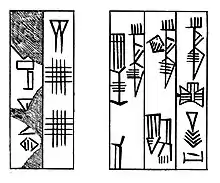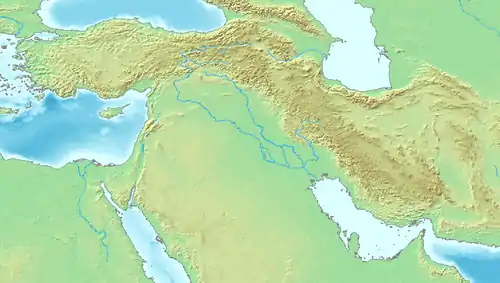Ukush
Ukush, also sometimes Uu or Bubu (Sumerian: 𒌑𒌑, which can be read u2-kuš3 or u2-u2),[1][2] was a Sumerian ruler (ensi) of the city-state of Umma (reigned c. 2350 BCE middle chronology).[3] He was the father of the famous Lugal-Zage-Si, who took control of all Sumer.[3]
| Ukush 𒌑𒌑 | |
|---|---|
| Governor of Umma | |
 | |
| Reign | c. 2350 BCE (MC) |
| Predecessor | Gishakidu |
| Successor | Lugal-Zage-Si (son) |
Ukush is known from the Nippur vase inscription[4][5] of Lugal-Zage-Si:
"Lugal-zagesi-si, King of Uruk, King of the Land, priest of Ana, prophet of Nidaba; the son of Ukush, patesi of Umma, the prophet of Nidaba; he who was favourably regarded by Ana, the king of the lands; the great patesi of Enlil; endowed with understanding by Enki; whose name was spoken by Babbar (the Sun-god), the chief minister of Enzu (the Moon-god), the representative of Babbar, the patron of Ninni, the son of Nidaba, who was nourished with holy milk by Ninkharsag, the servant of the god Mes, who is the priest of Uruk, the pupil of Ninabukkhadu, the mistress of Uruk, the Great Minister of the gods".
Other inscriptions, such as an inscription on a brick with a central hole in the Bible Lands Museum, also mention Lugalzagesi as "son of Ukush" (𒌉 𒌑𒌑, dumu u2-u2).[10] Another dedicatory inscription is also known.[11]
It is thought that he played an important role in making Umma a strong city with a powerful army, which allowed his son to achieve the defeat of neighbouring and traditional rival Lagash and its king Urukagina, and then the conquest of all Sumer.[12][13]
 Nippur vase of Lugalzagesi, where Lugalzagesi describes himself as "son of Ukush" (𒌉 𒌑𒌑, dumu u2-kuš3, in the 9th colum from top right.)
Nippur vase of Lugalzagesi, where Lugalzagesi describes himself as "son of Ukush" (𒌉 𒌑𒌑, dumu u2-kuš3, in the 9th colum from top right.)
See also
References
- "CDLI-Archival View". cdli.ucla.edu.
- Pongratz-Leisten, Beate (2015). Religion and Ideology in Assyria. Walter de Gruyter GmbH & Co KG. p. 147. ISBN 978-1-61451-426-8.
- Jones, C. H. W. (2012). Ancient Babylonia. Cambridge University Press. p. 36. ISBN 978-1-107-60572-5.
- "CDLI-Archival View". cdli.ucla.edu.
- Full text "Lugalzagesi translation". sumerianshakespeare.com.
- RIME 1.14.20.01 Frayne, Douglas R. 2007 FAOS 05/2, Lugazagesi 1 "CDLI-Archival View". cdli.ucla.edu.
- A History Of Sumer And Akkad. Chatto & Windus. 1916. p. 194.
- Sallaberger, Walther; Schrakamp, Ingo (2015). History & Philology (PDF). Walther Sallaberger & Ingo Schrakamp (eds), Brepols. pp. 80–81. ISBN 978-2-503-53494-7.
- Zólyomi, Gábor. The vase inscription of Lugal-zagesi and the history of his reign.
- RIME 1.12.07.01, ex. 01 "CDLI-Archival View". cdli.ucla.edu.
- RIME 1.12.07.01 composite Frayne, Douglas R. 2007 "CDLI-Archival View". cdli.ucla.edu.
- King, Leonard W. (1994). A history of Sumer and Akkad. Рипол Классик. p. 188. ISBN 978-5-87664-034-5.
- Hall, H. R. (2015). The Ancient History of the Near East: From the Earliest Times to the Battle of Salamis. Routledge. pp. 245–246. ISBN 978-1-317-27164-2.
| Regnal titles | ||
|---|---|---|
| Preceded by Gishakidu |
King of Umma c. 2350 BCE (middle) |
Succeeded by Lugal-Zage-Si |
